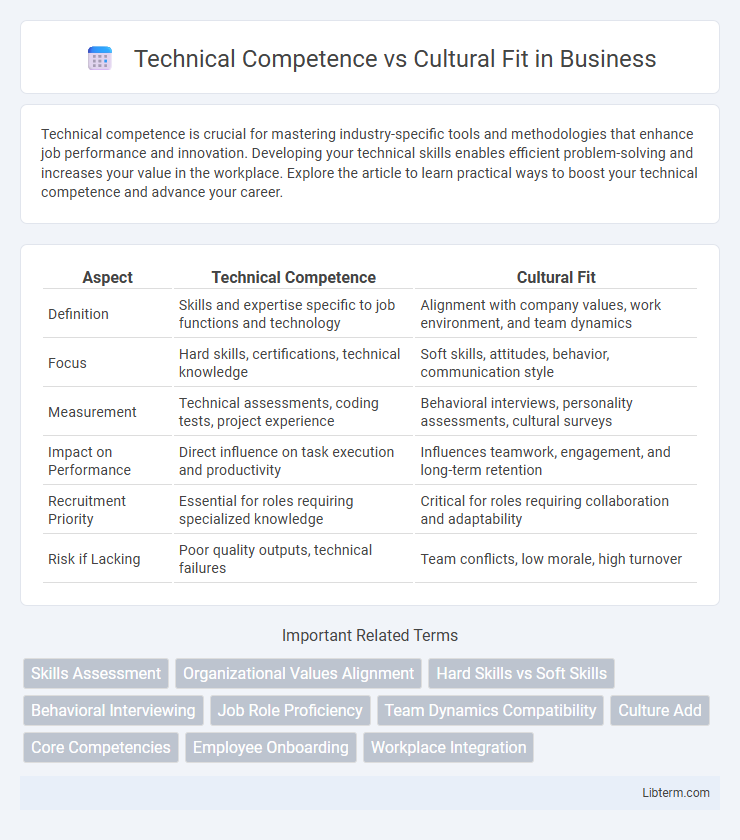Technical competence is crucial for mastering industry-specific tools and methodologies that enhance job performance and innovation. Developing your technical skills enables efficient problem-solving and increases your value in the workplace. Explore the article to learn practical ways to boost your technical competence and advance your career.
Table of Comparison
| Aspect | Technical Competence | Cultural Fit |
|---|---|---|
| Definition | Skills and expertise specific to job functions and technology | Alignment with company values, work environment, and team dynamics |
| Focus | Hard skills, certifications, technical knowledge | Soft skills, attitudes, behavior, communication style |
| Measurement | Technical assessments, coding tests, project experience | Behavioral interviews, personality assessments, cultural surveys |
| Impact on Performance | Direct influence on task execution and productivity | Influences teamwork, engagement, and long-term retention |
| Recruitment Priority | Essential for roles requiring specialized knowledge | Critical for roles requiring collaboration and adaptability |
| Risk if Lacking | Poor quality outputs, technical failures | Team conflicts, low morale, high turnover |
Understanding Technical Competence
Technical competence involves the mastery of specific skills, tools, and technologies essential for proficient job performance, including coding languages, software proficiency, and industry standards. Assessing this competence requires evaluating practical experience, certifications, and problem-solving abilities relevant to the technical demands of the role. Organizations prioritize technical competence to ensure employees can meet project requirements efficiently and uphold quality standards within their domains.
Defining Cultural Fit in the Workplace
Cultural fit in the workplace refers to alignment between an employee's values, beliefs, and behaviors with the organization's core culture and environment. This alignment fosters collaboration, enhances employee engagement, and supports cohesive teamwork, driving overall company performance. Assessing cultural fit involves evaluating interpersonal skills, communication styles, and adaptability to the company's mission and norms.
The Importance of Technical Skills
Technical skills are critical in ensuring employees can perform specific tasks and solve complex problems effectively within their roles. Mastery of relevant technologies, programming languages, or industry-specific tools directly influences productivity and innovation. Prioritizing technical competence helps organizations maintain competitive advantage and meet project deadlines with high-quality outcomes.
Why Cultural Fit Matters
Cultural fit influences employee engagement, collaboration, and long-term retention by aligning individual values with the company's mission and work environment. Employees who resonate with organizational culture demonstrate higher productivity and adaptability, reducing turnover costs. Prioritizing cultural fit ensures a cohesive workforce that supports innovation and effective teamwork, driving sustainable business success.
Balancing Skills and Values in Hiring
Balancing technical competence and cultural fit in hiring ensures candidates possess the necessary skills while aligning with the company's core values and work environment. Prioritizing both aspects enhances team collaboration, productivity, and long-term retention by fostering a cohesive workforce that drives innovation and shared goals. Effective recruitment strategies integrate skills assessment with cultural alignment metrics to create a sustainable and dynamic organizational culture.
Common Risks of Prioritizing One Over the Other
Prioritizing technical competence over cultural fit often leads to team misalignment, reduced collaboration, and increased turnover as individuals struggle to integrate with organizational values. Focusing solely on cultural fit risks hiring candidates lacking essential skills, resulting in diminished productivity and innovation. Balancing both aspects ensures a cohesive workforce capable of driving sustainable business growth and adaptability.
Assessing Technical Competence Effectively
Assessing technical competence effectively requires a structured evaluation of candidates' hard skills through practical tests, coding challenges, and relevant project portfolios. Utilizing standardized technical assessments alongside real-world problem-solving scenarios ensures accurate measurement of expertise and adaptability. Integrating peer reviews and continuous skill benchmarking enhances the reliability of technical competence evaluations in recruitment processes.
Evaluating Cultural Alignment in Candidates
Evaluating cultural alignment in candidates involves assessing their values, work style, and interpersonal skills to ensure compatibility with the organization's core principles and team dynamics. Behavioral interview questions and situational judgment tests help identify candidates who demonstrate empathy, adaptability, and collaboration, which are crucial for maintaining a positive workplace culture. Prioritizing cultural fit alongside technical competence enhances employee engagement, reduces turnover, and fosters long-term organizational success.
Integrating Technical and Cultural Assessments
Integrating technical and cultural assessments enhances the hiring process by ensuring candidates not only possess the necessary skills but also align with the company's core values and work environment. Structured interviews combining technical problem-solving tasks with behavioral questions reveal competency and cultural adaptability simultaneously. Utilizing psychometric tests alongside coding challenges provides a holistic evaluation, optimizing employee retention and team cohesion.
Building a Team for Long-Term Success
Technical competence ensures that team members possess the necessary skills and expertise to execute tasks effectively, directly impacting project quality and efficiency. Cultural fit promotes alignment with the organization's values and work style, fostering collaboration, communication, and employee retention. Balancing technical competence and cultural fit is critical for building a resilient team that adapts to challenges and drives long-term success.
Technical Competence Infographic

 libterm.com
libterm.com